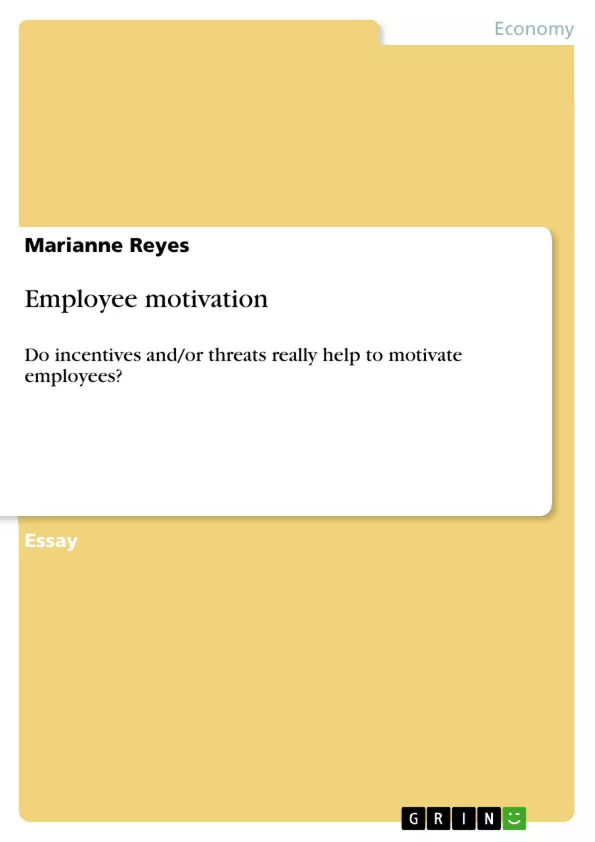This paper critically evaluates whether incentives and threats really help to motivate employees. For this purpose the phenomenon of motivation in this specific area will be illustrated and explained through multiple theories and practical examples.
A considerable amount of traditional theories in relation to motivation can be found in many books and journals. In fact, many influential traditional theorists such as Abraham Maslow’s Hierarchy of needs (1943), Douglas McGregor’s Theory X and Theory Y (1957) and Frederick Herzberg’s Dual-factor-theory (1986) wrote about motivation or people’s behaviour in general. On the other hand, Victor Vroom (1964) explained his opinion about work behaviour with his ‘Expectancy theory’. Some of these theorists support their views with different models.
Inhaltsverzeichnis (Table of Contents)
- Motivation - A Critical Evaluation of Incentives and Threats
- Motivation in the Workplace
- Intrinsic and Extrinsic Motivation
- Incentive Programs
- Non-Financial Rewards
- Problems Associated with Motivation
- Threats as Extrinsic Motivation
- Difficulties Associated with Rewards
- The Work Environment and Motivation
- Internal and External Environment
- Job Design and Motivation
- Conclusion
Zielsetzung und Themenschwerpunkte (Objectives and Key Themes)
This paper critically examines the effectiveness of incentives and threats in motivating employees. The author explores the concept of motivation in the workplace, differentiating between intrinsic and extrinsic motivation, and examines the role of incentive programs in driving employee performance. The paper also delves into the challenges associated with both threats and rewards, considering their potential impact on employee motivation and overall organizational dynamics. The author highlights the crucial role of the work environment in influencing employee motivation and discusses the importance of creating a positive and engaging work environment.
- The Effectiveness of Incentives and Threats in Motivating Employees
- The Distinction Between Intrinsic and Extrinsic Motivation
- The Impact of Incentive Programs on Employee Performance
- The Challenges Associated with Threats and Rewards
- The Role of the Work Environment in Influencing Employee Motivation
Zusammenfassung der Kapitel (Chapter Summaries)
- Motivation - A Critical Evaluation of Incentives and Threats: The paper begins by defining motivation and distinguishes between intrinsic and extrinsic motivation. It explores the theories of prominent motivation theorists such as Maslow, McGregor, Herzberg, and Vroom, highlighting the importance of both internal and external factors in motivating employees.
- Incentive Programs: This section examines the use of incentive programs in organizations. It emphasizes the importance of non-financial rewards, such as recognition and appreciation, as well as providing tangible benefits. Real-world examples, such as the InterContinental hotel chain's 'Celebration Week,' are used to illustrate the positive impact of non-financial rewards on employee morale and performance.
- Problems Associated with Motivation: This section explores the potential downsides of motivation strategies. It examines the theory of 'KITA' (Kick in the A**), which describes the use of threats and punishment as motivation. The paper argues that such methods can have detrimental effects on employee morale, trust, and commitment. It also explores the potential drawbacks of reward systems, such as reducing employee enthusiasm and creating a focus on rewards rather than intrinsic job satisfaction.
- The Work Environment and Motivation: This section highlights the significant impact of the work environment on employee motivation. It emphasizes the importance of a positive and engaging work environment, including job design and leadership styles. The author argues that a conducive work environment can contribute to increased productivity and job satisfaction.
Schlüsselwörter (Keywords)
This paper focuses on employee motivation, intrinsic and extrinsic motivation, incentives, threats, reward systems, work environment, job design, leadership, organizational success, and employee satisfaction.
- Quote paper
- BA (Hons) Marianne Reyes (Author), 2010, Employee motivation, Munich, GRIN Verlag, https://www.grin.com/document/168749



